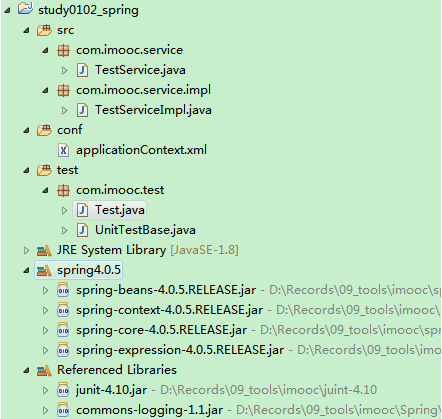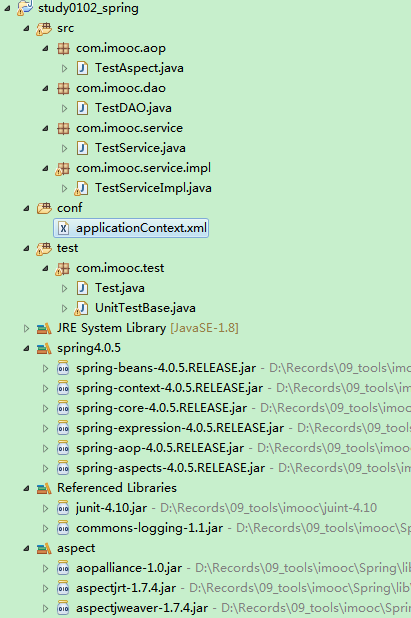IOC(控制反转):获得依赖对象的过程被反转了。控制被反转之后,获得依赖对象的过程由自身管理变为了由IOC容器自动注入。
DI(依赖注入):由IOC容器在运行期间,动态地将某种依赖关系注入到对象之中。
Bean容器初始化- FileSystemXmlApplicationContext("D:/*/.xml");
- ClasspathXmlApplicationContext("classpath:*.xml");
- AnnotationConfigApplicationContext(Application.class);
- Web应用:
<listener>
<listener-class>org.springframework.web.context.ContextLoaderListener</listener-class>
</listener>或
<servlet>
<servlet-name></servlet-name>
<servlet-class>org.springframework.web.context.ContextLoaderServlet</servlet-class>
<load-on-startup>1</load-on-startup>
</servlet>Spring注入:在启动Spring容器加载bean配置的时候,完成对变量的赋值行为。
常用的两种注入方式:
- 设值注入---set
- 构造注入---construction
目录结构
applicationContext.xml
<?xml version="1.0" encoding="UTF-8"?>
<beans xmlns="http://www.springframework.org/schema/beans"
xmlns:xsi="http://www.w3.org/2001/XMLSchema-instance"
xsi:schemaLocation="http://www.springframework.org/schema/beans
http://www.springframework.org/schema/beans/spring-beans.xsd" >
<bean id="testService" class="com.imooc.service.impl.TestServiceImpl"></bean>
</beans>TestService.java
package com.imooc.service;
public interface TestService {
void sayHello(String who);
}TestServiceImpl.java
package com.imooc.service.impl;
import com.imooc.service.TestService;
public class TestServiceImpl implements TestService {
@Override
public void sayHello(String who) {
System.out.println("Hi,"+who);
}
}UnitTestBase.java
package com.imooc.test;
import org.junit.After;
import org.junit.Before;
import org.springframework.beans.BeansException;
import org.springframework.context.support.ClassPathXmlApplicationContext;
public class UnitTestBase {
private String xmlPath;
private ClassPathXmlApplicationContext context;
public UnitTestBase(){
System.out.println("UnitTestBase无参构造");
}
public UnitTestBase(String xmlPath){
System.out.println("UnitTestBase参构造");
this.xmlPath = xmlPath;
}
@Before
public void before(){
System.out.println("before");
this.context = new ClassPathXmlApplicationContext(this.xmlPath);
}
@After
public void after(){
System.out.println("after");
context.destroy();
}
@SuppressWarnings("unchecked")
protected <T extends Object> T getBean(String beanId) {
try {
return (T)context.getBean(beanId);
} catch (BeansException e) {
e.printStackTrace();
return null;
}
}
protected <T extends Object> T getBean(Class<T> clazz) {
try {
return context.getBean(clazz);
} catch (BeansException e) {
e.printStackTrace();
return null;
}
}
}Test.java
package com.imooc.test;
import org.junit.runner.RunWith;
import org.junit.runners.BlockJUnit4ClassRunner;
import com.imooc.service.TestService;
@RunWith(BlockJUnit4ClassRunner.class)
public class Test extends UnitTestBase {
public Test(){
super("classpath*:applicationContext.xml");
System.out.println("Test构造方法!");
}
@org.junit.Test
public void testBean(){
TestService t = super.getBean("testService");
t.sayHello("Tom");
}
}被称作 bean 的对象是构成应用程序的支柱也是由 Spring IoC 容器管理的。bean 是一个被实例化,组装,并通过 Spring IoC 容器所管理的对象。这些 bean 是由用容器提供的配置元数据创建的。
<?xml version="1.0" encoding="UTF-8"?>
<beans xmlns="http://www.springframework.org/schema/beans"
xmlns:xsi="http://www.w3.org/2001/XMLSchema-instance"
xsi:schemaLocation="http://www.springframework.org/schema/beans
http://www.springframework.org/schema/beans/spring-beans.xsd" >
<!--
id/name:这个属性指定唯一的 bean 标识符。在基于 XML 的配置元数据中,你可以使用 ID 和/或 name 属性来指定 bean 标识符。
class:这个属性是强制性的,并且指定用来创建 bean 的 bean 类。
scope:这个属性指定由特定的 bean 定义创建的对象的作用域,默认为singleton。
lazy-init:延迟初始化的 bean 告诉 IoC 容器在它第一次被请求时,而不是在启动时去创建一个 bean 实例。
-->
<bean id="testService" class="com.imooc.service.impl.TestServiceImpl"></bean>
</beans><bean id="javaCollection" class="com.imooc.JavaCollection">
<!-- results in a setAddressList(java.util.List) call -->
<property name="addressList">
<list>
<value>INDIA</value>
<value>Pakistan</value>
<value>USA</value>
<value>USA</value>
</list>
</property>
<!-- results in a setAddressSet(java.util.Set) call -->
<property name="addressSet">
<set>
<value>INDIA</value>
<value>Pakistan</value>
<value>USA</value>
<value>USA</value>
</set>
</property>
<!-- results in a setAddressMap(java.util.Map) call -->
<property name="addressMap">
<map>
<entry key="1" value="INDIA"/>
<entry key="2" value="Pakistan"/>
<entry key="3" value="USA"/>
<entry key="4" value="USA"/>
</map>
</property>
<!-- results in a setAddressProp(java.util.Properties) call -->
<property name="addressProp">
<props>
<prop key="one">INDIA</prop>
<prop key="two">Pakistan</prop>
<prop key="three">USA</prop>
<prop key="four">USA</prop>
</props>
</property>
</bean>从Spring3.0开始,Spring JavaConfig项目提供了很多特性,包括使用java而不是xml定义的bean,如:
- @Configuration
- @Bean
- @Import
- @DependsOn
- @Component,通用注解,可用于任一个bean
- @Repository,通常用于DAO类,持久层
- @Service,通常用于Service类,服务层
- @Controller,通常用于Controller类,控制层
<context:annotation-config> 是用于激活那些已经在spring容器里注册过的bean面的注解;
<context:component-scan>除了具有<context:annotation-config>的功能之外,还可以在指定的package下扫描以及注册javabean;通常使用了<context:component-scan>,就不再使用<context:annotation-config>。
关于这两个,具体可参考:https://www.cnblogs.com/leiOOlei/p/3713989.html
bean的作用域@Scope通常情况下自动查找的Spring组件,其scope是singleton(单列模式),Spring2.5提供了一个标识scope的注解@Scope。
@Scope("prototype")
@Repository
public class TestServiceImpl implements TestService{
...
}@Autowired
可以将@Autowired理解为传统的setter方法,可用于构造器或成员变量上。
public class TestServiceImpl implements TestService {
//@Autowired 成员变量上
private TestDAO testDAO;
public TestServiceImpl(){
System.out.println("TestServiceImpl is created a instance.");
}
@Autowired //构造器上
public TestServiceImpl(TestDAO testDAO){
this.testDAO = testDAO;
}
//@Autowired setter方法上
public void setTestDAO(TestDAO testDAO) {
System.out.println("testDAO is injected.");
this.testDAO = testDAO;
}
@Override
public void sayHello(String who) {
System.out.println("Hi,"+who);
}
}@Autowired 的(required=false)选项
默认情况下,@Autowired 注释意味着依赖是必须的,它类似于 @Required 注释,然而,你可以使用 @Autowired 的 (required=false) 选项关闭默认行为。
面向切面编程AOP通过预编译方式和运行期动态代理,实现程序功能的统一维护的一种技术。
主要功能是:日志记录、性能统计、安全控制、事务处理、异常处理。
AOP相关点介绍- 切面Aspect:一个关注点的模块化,这个关注点可能会横切多个对象;
- 连接点Joinpoint:程序执行过程中的某个特定的点;
- 通知Advice:在切面某个特定的连接点上执行的动作;
- 切入点Pointcut:匹配连接点的断言,在AOP中通知和一个切入点表达式关联;
- 引入Introduction:在不修改类代码的前提下,为类添加新的方法和属性;
- 目标对象Target Object:被一个或多个切面通知的对象;
- AOP代理AOP Proxy:AOP框架创建的对象,用来实现切面契约(aspect contract)(包括通知方法执行等功能);
- 织入Weaving:把切面连接到其他的应用程序或者对象上,并创建一个被通知的对象,分为编译时织入、类加载时织入、执行时织入。
- 前置通知Before advice:在某个连接点之前执行的通知,但不能阻止连接点前的执行(除非抛出一个异常);
- 返回后通知After returning advice:在某个连接点正常完成后执行的通知;
- 抛出异常后通知After throwing advice:当方法抛出异常退出时执行的通知;
- 后通知After(finally)advice:当某个连接点退出的时候执行的通知,不论是正常返回还是异常返回;
- 环绕通知Around advice:包围一个连接点的通知,通知方法的第一个参数必须是ProceedingJoinPoint类型。
- execution(public * *(..)) 执行所有public方法时
- execution(* set*(..)) 执行所有set开始的方法时
- execution(* com.imooc.service.TestService.*(..)) 执行TestService类中所有的方法时
- execution(* com.imooc..(..)) 执行com.imooc包下所有的方法
- execution(* com.imooc...(..)) 执行com.imooc及其子包下所有的方法
目录结构
applicationContext.xml
<?xml version="1.0" encoding="UTF-8"?>
<beans xmlns="http://www.springframework.org/schema/beans"
xmlns:xsi="http://www.w3.org/2001/XMLSchema-instance"
xmlns:context="http://www.springframework.org/schema/context"
xmlns:aop="http://www.springframework.org/schema/aop"
xsi:schemaLocation="http://www.springframework.org/schema/beans
http://www.springframework.org/schema/beans/spring-beans.xsd
http://www.springframework.org/schema/context
http://www.springframework.org/schema/context/spring-context.xsd
http://www.springframework.org/schema/aop
http://www.springframework.org/schema/aop/spring-aop.xsd" >
<bean id="testService" class="com.imooc.service.impl.TestServiceImpl">
<property name="testDAO" ref="testDAO"></property>
</bean>
<bean id="testDAO" class="com.imooc.dao.TestDAO"></bean>
<!-- 切面实例-->
<bean id="testAspect" class="com.imooc.aop.TestAspect"></bean>
<aop:config>
<aop:aspect id="testAspectAOP" ref="testAspect">
<aop:pointcut expression="execution(* com.imooc.service.impl.*Impl.*(..))" id="testBusiness"/>
<aop:before pointcut-ref="testBusiness" method="before"/>
</aop:aspect>
</aop:config>
</beans>TestAspect.java
package com.imooc.aop;
public class TestAspect {
public void before(){
System.out.println("我是切面~~~");
}
}
运行结果
UnitTestBase有参构造
Test构造方法!
before
TestServiceImpl is created a instance.
TestDAO is created a instance.
testDAO is injected.
我是切面~~~
Hi,Tom
after共同学习,写下你的评论
评论加载中...
作者其他优质文章






